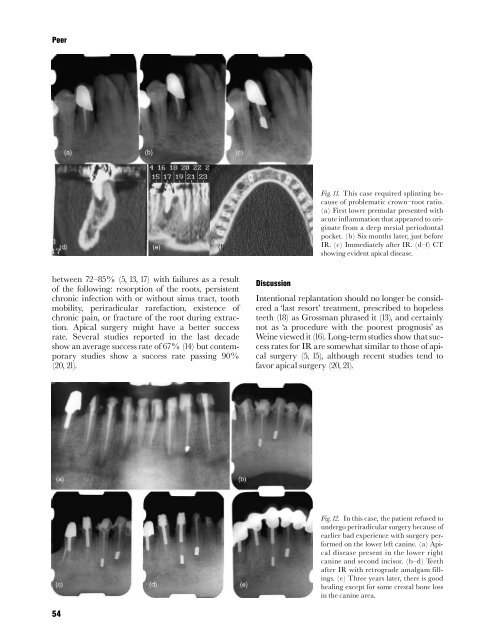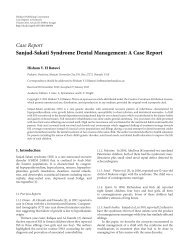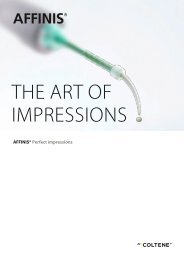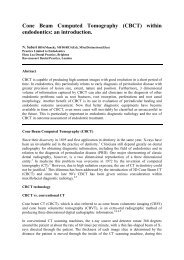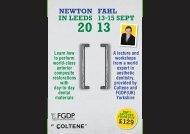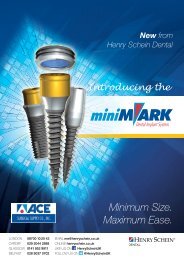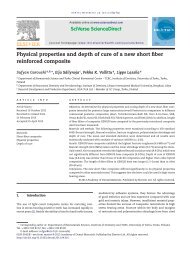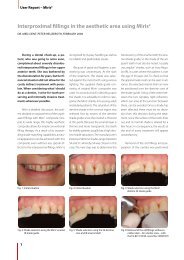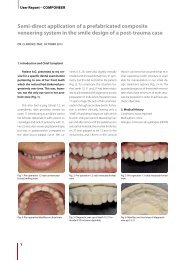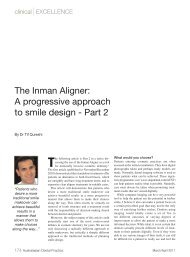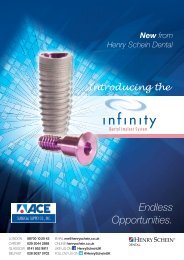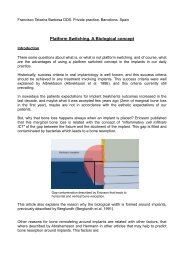Intentional replantation ^ a `last resort' treatment or a ...
Intentional replantation ^ a `last resort' treatment or a ...
Intentional replantation ^ a `last resort' treatment or a ...
Create successful ePaper yourself
Turn your PDF publications into a flip-book with our unique Google optimized e-Paper software.
Peer<br />
Fig. 11. This case required splinting because<br />
of problematic crown^root ratio.<br />
(a) First lower premolar presented with<br />
acute inflammation that appeared to <strong>or</strong>iginate<br />
from a deep mesial periodontal<br />
pocket. (b) Six months later, just bef<strong>or</strong>e<br />
IR. (c) Immediately after IR. (d^f) CT<br />
showing evident apical disease.<br />
between 72^85% (5, 13, 17) with failures as a result<br />
of the following: res<strong>or</strong>ption of the roots, persistent<br />
chronic infection with <strong>or</strong> without sinus tract, tooth<br />
mobility, periradicular rarefaction, existence of<br />
chronic pain, <strong>or</strong> fracture of the root during extraction.<br />
Apical surgery might have a better success<br />
rate. Several studies rep<strong>or</strong>ted in the last decade<br />
show an average success rate of 67% (14) but contemp<strong>or</strong>ary<br />
studies show a success rate passing 90%<br />
(20, 21).<br />
Discussion<br />
<strong>Intentional</strong> <strong>replantation</strong> should no longer be considered<br />
a <strong>`last</strong> <strong>res<strong>or</strong>t'</strong> <strong>treatment</strong>, prescribed to hopeless<br />
teeth (18) as Grossman phrased it (13), and certainly<br />
not as `a procedure with the po<strong>or</strong>est prognosis' as<br />
Weine viewed it (16). Long-term studies show that success<br />
rates f<strong>or</strong> IR are somewhat similar to those of apical<br />
surgery (5, 15), although recent studies tend to<br />
fav<strong>or</strong> apical surgery (20, 21).<br />
Fig. 12. In this case, the patient refused to<br />
undergo periradicular surgery because of<br />
earlier bad experience with surgery perf<strong>or</strong>med<br />
on the lower left canine. (a) Apical<br />
disease present in the lower right<br />
canine and second incis<strong>or</strong>. (b^d) Teeth<br />
after IR with retrograde amalgam fillings.<br />
(e) Three years later, there is good<br />
healing except f<strong>or</strong> some crestal bone loss<br />
in the canine area.<br />
54


